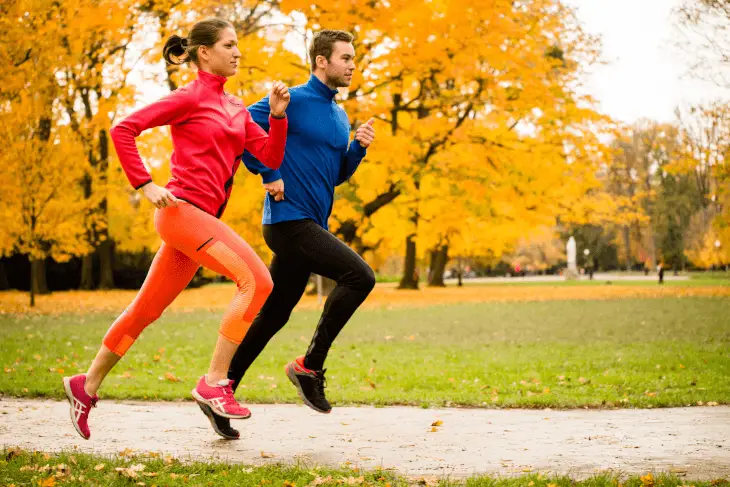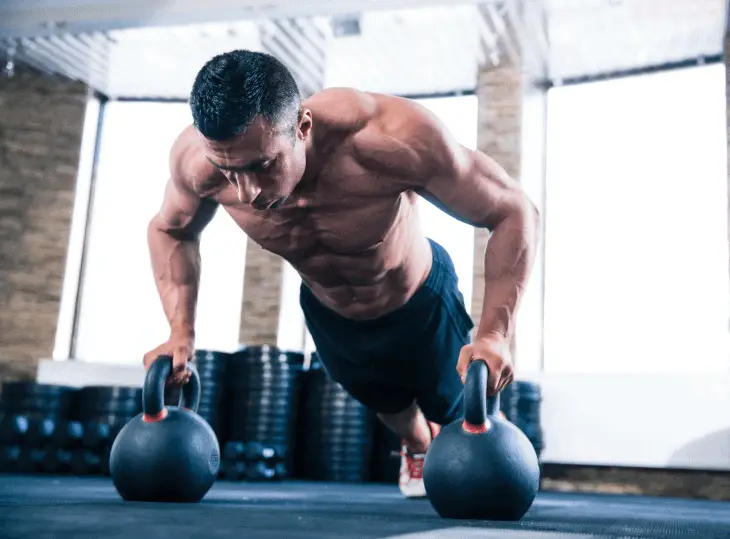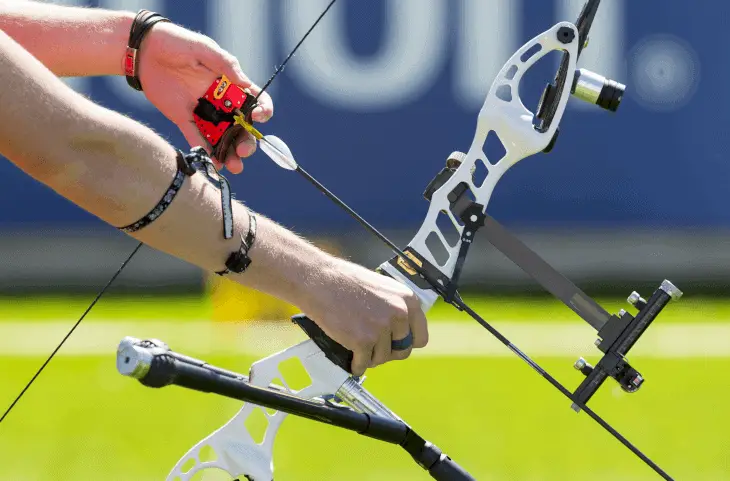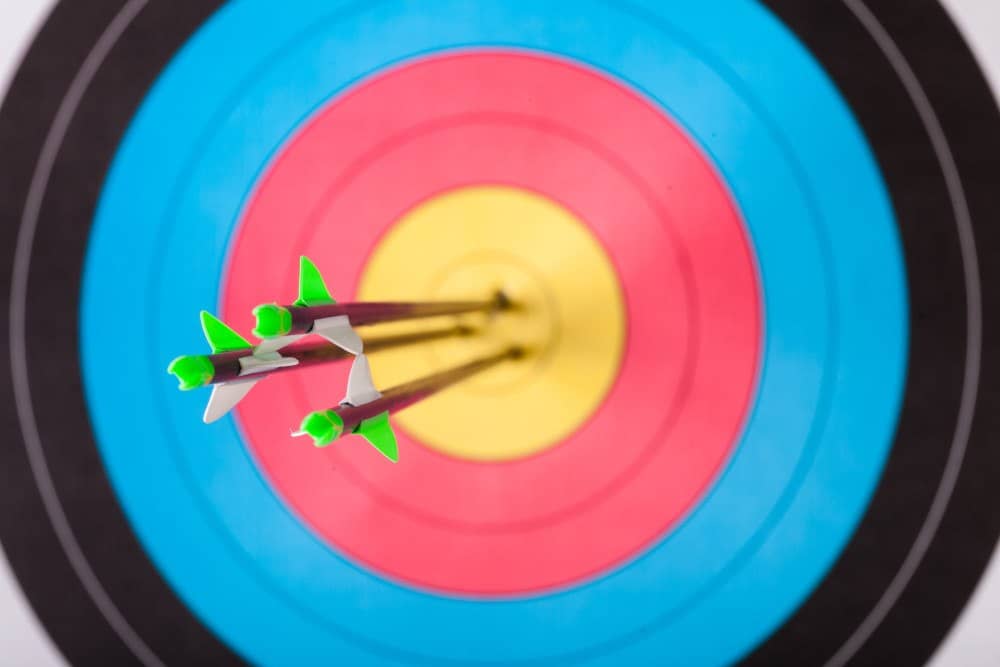It’s an odd thing: as archers, we consider ourselves athletes, but if you ask many of us how we fine-tune our bodies to become better archers, we’d probably give you a blank stare. When we want to improve, we work on focus and aim, and we tend to overlook the physical, body-building aspect of archery. For many of us, it doesn’t even occur to us that we could become better archers by getting more in-shape.
It’s kind of like the golfing community, before Tiger Woods came along. The stereotypical golfer was a middle-aged guy, maybe a little out-of-shape, and if you asked him how he worked on his game, he’d talk about his swing—and he wouldn’t make any mention of strength-training or stamina. Tiger Woods changed all that, by working on his physique, and incorporating strength into his swing, and changed golf forever.
So here, let’s talk about archery exercises can improve your game. We’ll provide a list of exercises below, the muscles they work on, and why they’re so important to archery. There’s a strong chance they’ll make you into a more capable, more accurate archer, and if they don’t—well, they’ll get you healthy!
(One thing we should note, before we dive in: we’re not doctors and we’re not trained physical therapists. These are all pretty well-known exercises that are known to benefit archers, but before you dive into exercise, you’ll want to check with your doctor or physician and get his/her sign-off).
OK, ready? Let’s get to it. The first exercise you can use to become a better archer is…
Any and All Types of Cardio
How Cardio Helps You: Regardless of whether you’re in the woods bowhunting or at target competition, cardio provides both the stamina and stable footing needed for accuracy and endurance. Target archers know that competitions can be extremely long—and tiring!—and bowhunters will often find themselves on long-distance treks pursuing, tracking, or returning from their hunt. Without proper cardio, moving around in the forest can be exhausting and difficult, getting in the way of a successful hunt.
There’s a reason why we listed this as our #1 archery exercise—it’s absolutely vital to your success as an archery, and we all seem to forget about it!

How to Do It: Countless forms of cardiovascular exercise are out there, so we recommend one of three different activities: swimming, rowing, and running. First, swimming: a pool, ocean, or lake nearby can provide an intense cardio workout that is as low impact as possible. Second, rowing: rowing machines are another low-impact option that you can do at home or at the gym, and just a few minutes of rowing is enough for a full-body workout. Lastly, running: even a short job provides full-body engagement but a higher level of impact, and, as they say, “the roads are always open.”
Helpful Tips: While all the activities above can provide tremendous benefits, swimming tends to be the top choice amongst archers for its low impact level combined with the additional upper body exercise.
Yoga and Meditation
How Yoga and Meditation Help You: When the time comes to draw the arrow, focus and stability are of the utmost importance. Along with improved flexibility, stamina, and core strength, yoga helps us concentrate on each part of our bodies performing in the way we want. It brings recognition to the breath, stance, draw, and release, helping to perfect each little movement and positioning. Meditation brings this kind of focus and self-control while under the pressure and adrenaline of competition or a hunt.

How to Do It: If you’re looking for instruction, you’re in luck: resources for both yoga and meditation are widely available online, and there are literally thousands of fantastic videos on YouTube to guide you. You can save some time, too, because these two exercises work both your body and mind and are often combined into one practice.
Helpful Tips: Yoga and meditation take both practice and patience. They can be difficult skills to feel comfortable in, but both are worth the time and openness needed. Consider taking local yoga or meditation classes to help get you on the right track, and then begin to practice independently at home (which is free!).
Planks / Planking
How Planks Help You: As archers, we tend to focus a lot on our arms and back, and forget our all-important “core” muscles. Planks are among the top exercises to strengthen the core, because they develop the…
Transversus abdominus. The transversus abdominus is a long, muscular sheet located on the lateral sides of your abdominal wall. It’s the foundation of all ab muscles, and will help the core become more stable;
Obliques. You may know obliques by their more “casual” term, which is your “six-pack.” And, yes, even if you’ve got some padding on you—and most of us do!—your six pack is in there. Obliques assist in the twisting of the waist, which will help hold a steady positioning while having the bow drawn, which—well, that’s pretty darn important. Finally, there’s your…
Glutes. The common term for your glutes is your “butt” or your “booty,” and while it may sound odd, your butt/booty is really important for your accuracy. The glutes give support to the back, which help improve posture, another key part of getting the right technique for archers.

How to Do It: Planks are an incredibly simple, equipment-free exercise. For standard planks, find a softer surface (like a yoga mat), get onto your belly, and raise your body on your elbows and forearms. Holding the body level and straight will be the best plank workout. Be sure you are supporting your back and your glutes are also level with the rest of your body, not up in the air.
There are other versions of planks, such as side planks and high planks, and those are great to target different parts of your core. To adjust to a high plank, move up onto flat palms with extended arms, keeping your whole body straight. From here, a side plank only involves twisting to one side or the other, onto one hand, and holding with an extended arm.
Helpful Tips: This is one of those archery exercises that’s tough at first, but gets easier with time. Thirty-day plank challenges are a slow progression into a more intense plank workout that will quickly strengthen your core and make planks easier by the day. Focus first on form when doing planks, and then as you build more strength, you can add more time and variation to your planking.
The Old Main-Stay: Push-Ups
How Push-ups Help You: Push-ups target the pectoral muscles, triceps, and muscle groups in the back of your shoulders. These are the muscles we all consider the most important to archers, and that’s because… well, they’re pretty important to archers of all stripes!
Push-ups are great, because in addition to increasing upper body performance, they demand an understanding of core and hip stability. This is an easy exercise to build muscles that will help you draw the bow and improve stability in the shoulders.

How to Do It: To do a perfect push-up, your form is everything. A push-up is simply a movement from a high plank into a lower position and back up (and that’s why we discussed planks first). Your hands should be shoulder-width apart or slightly wider, with your fingers splayed out for stability. The perfect push-up means lowering your body with your arms until your elbows are at a forty-five-degree angle. Another key part of push-ups is remembering to have your core engaged throughout the entire exercise. This will keep your body straight and work more muscle groups.
Helpful Tips: Instead of trying to see how many push-ups you can do, work towards perfecting your form. When it comes to strength-building, one push-up done with great form is better for you than three push-ups done with poor form. We recommend starting with what is more comfortable and adjusting slowly to an ideal angle. All of our bodies are different, and getting the most out of every exercise requires some “personal tuning”—you need to pay attention to your body as you move through the push-up. If you need to, as you build strength, perform some push-ups on your knees so you can push slightly past your limit each time.
Single-Arm Dumbbell Row
How Single-arm Dumbbell Rows Help You: You might imagine it to be true, but it makes sense when you think about it: the single-arm dumbbell row is the closest an exercise on our list gets to imitating the action of drawing a bow. A dumbbell row strengthens your latissimus dorsi, located in the middle of the back, which is the same muscle engaged while drawing. Additionally, your lower body and core are engaged during this exercise to provide stability to your torso (the same process the body performs while shooting).

How to Do It: For this exercise, a bench or other solid surface is needed for your leg to rest on, as well as a dumbbell, as the name suggests. Start by making sure the bench is stable and place your knee on it. Ensure your back is parallel to the ground and your core is engaged; use your opposite hand to grab the dumbbell from the ground. Pull the dumbbell into your chest, and slowly lower it back to the ground.
Helpful Tips: There are several different forms of dumbbell rows. Trying out additional forms can strengthen supporting muscle groups, which can improve individual muscle performance. As with all exercises, start slow and work up to heavier weights and more difficult practices. This exercise pairs well with a rowing machine, which will increase the stamina in the muscles the dumbbell row builds strength in. If you do experiment with different forms of dumbbell rows, be careful, and as always, pay special attention to your form.
Dumbbell Lateral Raise
How Dumbbell Lateral Raises Help You: Your deltoid muscles are at the top of your arms near your shoulders—think of the location where sailors used to get their heart tattoos, and you’re close.
Building up the deltoids does three important things: 1) it dramatically improves the support your bow receives from your front arm, 2) strengthens you as you draw the bowstring, and 3) provides you with strong shoulders so that you can keep a steady position while drawing and aiming.
A lateral raise incorporated into a routine builds shoulder strength up better than most exercises, because strengthens the shoulders and provides increased mobility—which helps for a smoother and more precise draw.

How to Do It: This archery exercise can be done with either a single-arm or both arms simultaneously. With a dumbbell in each hand and a straight arm, raise the weights until your arms are level with your shoulders. Slowly lower the weights back down to your side, maintaining straight arms throughout.
Helpful Tips: Be careful with this one. Well, be careful with all of them, but be careful with this one specifically. Whatever weight you want to start with, choose something lighter, and avoid missing weeks of training due to an injury. Plus, you’re more likely to improve muscle stamina by performing more repetitions with lighter weights.
Barbell Pullovers
How Barbell Pullovers Help You: Barbell pullovers are very similar to dumbbell rows—they target the latissimus dorsi and help with drawing and steadying the bowstring. Barbell pullovers also target the triceps and deltoids, and they complement the push-ups and lateral raises to build muscles that strengthen your front arm to steady the bow while drawn. This exercise also works your core, adding more work to helping perfect your shooting stance.
How to Do It: The barbell pullover requires a bench and barbell with weights at your level. Start by laying on your back on the bench, flexing your hips, and getting your feet in a solid stance. Grab the barbell from your chest, and with your elbows slightly bent, bring the barbell up and over your head until your arms are parallel to your body, or your shoulders are fully flexed.
Helpful Tips: This is another one you want to be careful with, because… well, because if you mess up, you can drop a barbell on your head!
Try this exercise with only your back on the bench and your lower body off. This acts as a counterweight, helping to keep good form and exercise the core. Pay attention to your hips, and make sure they don’t rise upwards too much and endanger your back.
Bench/Tricep Dips
How Bench/Tricep Dips Help You: Drawing the bow back repeatedly takes stamina, and the act of keeping your arm locked forward when anchored strains your triceps. Tricep dips can increase the endurance you feel in your triceps, which can be great—especially if you’re shooting a compound bow, and taking a while to aim.

How to Do It: The bench or tricep dip is another simple bodyweight exercise. The only thing required is a stable object, such as a bench or even a chair, to brace your hands. Start by sitting on the bench or chair and placing your hands on the bench at your side with fingers facing forwards. Walk your feet out, at about hip-width, legs fully extended, until clear of the chair. Lower your body until your elbows hit an angle between forty-five and ninety. Push yourself back up to your start position slowly, and repeat. Wallah! You’re doing the dip.
Helpful Tips: As with all of our exercises, you need to take it easy—especially at first—and not go too far: lowering yourself too far down can lead to a shoulder injury, and that’s pretty much “game over” for an archer (at least until it heals). Make sure to hit the right angle, then come back up. To keep the triceps engaged throughout the entire exercise, do not lock the elbows when fully extended up. Keeping a slight bend will maintain a workout on the triceps.
Romanian Deadlifts
How Romanian Deadlifts Help You: This exercise is more geared to the bowhunters in the audience. Climbing over logs, jumping streams, and long hunts will all become easier with this exercise, and not only can it improve your overall strength, it can solidify a solid stance. Deadlifts target your hamstrings and glutes that support lower back muscles, increasing coordination, and supporting a strong posture, and that’s all fantastic.

How to Do It: This exercise starts with the barbell in your hands, standing with feet at shoulder width. With a bend in the knees and a straight back, bend forward at the hip. When the barbell gets to your knees, a pulling tension should appear in your hamstrings. Once you are at this point, power upwards with your hips and legs into the starting position.
Helpful Tips: The same rules apply in this exercise that applies when moving a couch into a new apartment. Lift with your legs, and not your back. It’s easy to get injured performing a deadlift, so ensure your form is on point each time.
And there you have it! Nine exercises that can reinvigorate your archery performance—and make you healthier in the meantime!
How to Make These Exercises Part of Your Routine
So, now that you know a bunch of exercises that’ll help your archer game, you’re good to go, right?
Not so fast.
Most of us have tried working out before… and that means that most of us have also experienced the difficulty that comes along with keeping exercise in our lives! Routine is difficult to establish, and we’re willing to bet the majority of people start with great intentions… but peter out after a short while.
The good news is, once it’s there and the habit is formed, it will be easier to stick to, and the following tips can help you stay on-track:
Be Easy on Yourself
Here’s the truth of it: messing up and missing days is just about a guarantee. Life gets in the way, and going to the gym takes a backseat. It happens! Forgive yourself, accept that these things will happen, and then get back in the saddle. What is most important is that you will get back to it tomorrow.
Along with messing up, go easy on yourself. Going to a gym and picking up the heaviest weights you can find is a bad, bad idea. Start slow and build instead. Archery requires patience, and what better way to practice patience than building your body slowly?
While you’re taking it slow, realize that your workouts don’t need to be “epic” to be worthwhile. Go to the gym for five minutes, or do a 10-minute workout at home. If that’s all the time you have or can get yourself to commit to, then use it. The hardest part of working out is often getting yourself to go. If you break the barrier, you may find yourself at the gym for hours.
Find a Buddy
Trust us on this one: getting to the gym and working out is much easier when you get friends involved. Because you want to hang out with a pal, you’re more likely to go in the first place, and when you’re there, you’re more likely to enjoy yourself, and stay for a while—and do more working out.
If you don’t already hit the gym with a friend, think of the people in your life you could ask. Maybe you already have a hunting buddy who wants to start hitting the gym regularly, or you know somebody at the range who wants to take their practice up a notch. Whoever it is, get them involved—it’ll be good for everyone!
Having a workout partner not only makes it more enjoyable, but you have someone that will hold you accountable—and the number of exercises you can do will expand significantly once you have a spotter.
Post Your Schedule
You alone know yourself best. You know if you like to get home and lay on the couch for twenty minutes before starting back on projects, or if, once you sit down on that couch, you’re stuck there! So, find a routine that works for you. Put exercise in the morning if you like to get up early, or the evening if you lean more towards a night-owl lifestyle.
Then, write it down and put it on the fridge or anywhere you will see it daily. Having it up somewhere at home to see will be a good reminder, especially as you are in the early stages of building the routine. Routine merely is getting yourself to do the same thing over and over again until you don’t think about it and it has become a habit.
Seeing your schedule will help you know when you are supposed to be doing what and keeping you accountable for following it.
Set Up a Reward System
Establish a reward system with yourself. Allow yourself days off or special meals if you can stick to your workout routine for the whole week. Cheat days aren’t cheating if you plan it in to make the routine successful.
Plus, exercising is hard and making it a routine can be even more challenging. We deserve to give ourselves a little something extra.
Now Get Out There and Get Fit!
There you have it—nine exercises that work all the muscles you’ll use in your archery practice, and some tips on how to make them a part of your life. Take it easy, but stick with it, and before you know it, you’ll probably see benefits in multiple areas of your life—in addition to archery! You can do it—we’re rooting for you!
Author Ian Standard is a guide for a wilderness therapy program in Southeast Alaska, and a teacher at a K-3 outdoors school in Asheville, North Carolina.



